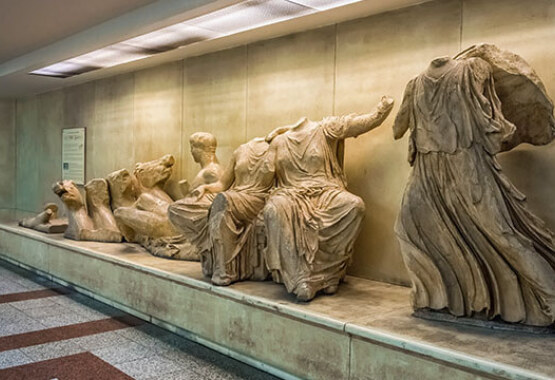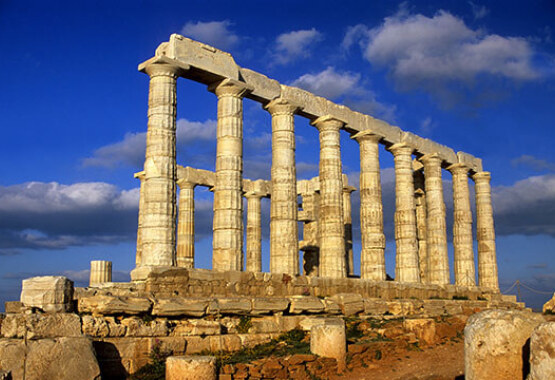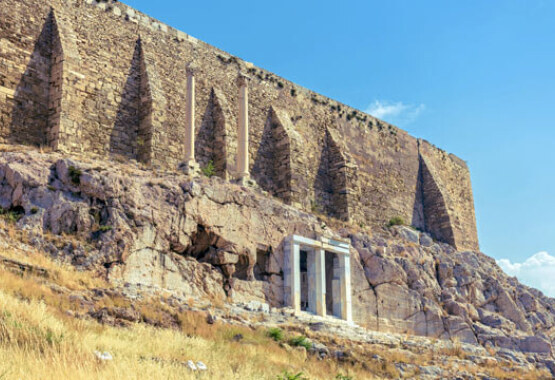
ATHENS
The Acropolis of the fifth century BC is the most accurate reflection of the splendour, power and wealth of Athens at its greatest peak, the golden age of Perikles.
Pottery sherds of the Neolithic period (4000/3500-3000 BC) and, from near the Erechtheion, of the Early and Middle Bronze Age, show that the hill was inhabited from a very early period. A fortification wall was built around it in the thirteenth century BC and the citadel became the centre of a Mycenaean kingdom. This early fortification is partially preserved among the later monuments and its history can be traced fairly accurately.
The Acropolis became a sacred precinct in the eighth century BC with the establishment of the cult of Athena Polias, whose temple stood at the northeast side of the hill. The sanctuary flourished under Peisistratos in the mid-sixth century BC, when the Panathinaia, the city's greatest religious festival, was established and the first monumental buildings of the Acropolis erected, among them the so-called “Old temple” and the Hekatompedos, the predecessor of the Parthenon, both dedicated to Athena. The shrine of Artemis Brauronia and the first monumental propylon also date to this period.
Numerous opulent votive offerings, such as marble korai and horsemen, bronze and terracotta statuettes, were dedicated to the sanctuary. Several of these bear inscriptions that show the great importance of Athena's cult in the Archaic period.
After the Athenians defeated the Persians at Marathon, in 490 BC, they began building a very large temple, the so-called Pre-Parthenon. This temple was still unfinished when the Persians invaded Attica in 480 BC, pillaged the Acropolis and set fire to its monuments. The Athenians buried the surviving sculptures and votive offerings inside natural cavities of the sacred rock, thus forming artificial terraces, and fortified the Acropolis with two new walls, the wall of Themistokles along the northern side and that of Kimon on the south. Several architectural elements of the ruined temples were incorporated in the northern wall and are still visible today.
In the mid-fifth century BC, when the Acropolis became the seat of the Athenian League and Athens was the greatest cultural centre of its time, Perikles initiated an ambitious building project which lasted the entire second half of the fifth century BC. Athenians and foreigners alike worked on this project, receiving a salary of one drachma a day. The most important buildings visible on the Acropolis today - that is, the Parthenon, the Propylaia, the Erechtheion and the Τemple of Athena Nike, were erected during this period under the supervision of the greatest architects, sculptors and artists of their time.
The temples on the north side of the Acropolis housed primarily the earlier Athenian cults and those of the Olympian gods, while the southern part of the Acropolis was dedicated to the cult of Athena in her many qualities: as Polias (patron of the city), Parthenos, Pallas, Promachos (goddess of war), Ergane (goddess of manual labour) and Nike (Victory).
After the end of the Peloponnesian war in 404 BC and until the first century BC no other important buildings were erected on the Acropolis. In 27 BC a small temple dedicated to Augustus and Rome was built east of the Parthenon. In Roman times, although other Greek sanctuaries were pillaged and damaged, the Acropolis retained its prestige and continued to attract the opulent votive offerings of the faithful.
Αfter the invasion of the Herulians in the third century AD, a new fortification wall was built, with two gates on the west side. One of these, the so-called Beulé Gate, named after the nineteenth century French archaeologist who investigated it, is preserved to this day.
In subsequent centuries the monuments of the Acropolis suffered from both natural causes and human intervention. After the establishment of Christianity and especially in the sixth century AD the temples were converted into Christian churches. The Parthenon was dedicated to Parthenos Maria (the Virgin Mary), was later re-named Panagia Athiniotissa (Virgin of Athens) and served as the city's cathedral in the eleventh century. The Erechtheion was dedicated to the Sotiras (Saviour) or the Panagia, the Temple of Athena Nike became a chapel and the Propylaia an episcopal residence.
The Acropolis became the fortress of the medieval city. Under Frankish occupation (1204-1456) the Propylaia were converted into a residence for the Frankish ruler and in the Ottoman period (1456-1833) into the Turkish garrison headquarters. The Venetians under F. Morozini besieged the Acropolis in 1687 and on September 26th bombarded and destroyed the Parthenon, which then served as a munitions store. Lord Elgin caused further serious damage in 1801-1802 by looting the sculptural decoration of the Parthenon, the temple of Athena Nike and the Erechtheion. The Acropolis was handed over to the Greeks in 1822, during the Greek War of Independence, and Odysseas Androutsos became its first Greek garrison commander.
After the liberation of Greece, the monuments of the Acropolis came under the care of the newly founded Greek state. Limited investigation took place in 1835 and 1837, while in 1885-1890 the site was systematically excavated under P. Kavvadias. In the early twentieth century N. Balanos headed the first large-scale restoration project. A Committee for the Conservation of the Monuments on the Acropolis was created in 1975 with the aim to plan and undertake large-scale conservation and restoration on the Acropolis. The project, conducted by the Service of Restoration of the Monuments of the Acropolis in collaboration with the First Ephorate of Prehistoric and Classical Antiquities, is still in progress.
The sacred rock is approached from the West through the Beulé gate, one of the two gates built after the third century AD Herulian invasion, or through a small door under the temple of Athena Nike. The visitor then approaches the Propylaia, the monumental entrance to the sanctuary, built in Classical times by architect Mnesikles. The temple of Athena Nike, built c. 420 BC by Kallikrates, dominates the bastion to the south of the Propylaia.
Near the temple was the shrine of Aphrodite Pandemos, of which only part of the epistyle is preserved. Opposite the north wing of the Propylaia is a tall rectangular pedestal known as the pedestal of Agrippas, because it once supported an offering by the city of Athens to Marcus Agrippas, son-in-law of Augustus.
Through the Propylaia one enters the sanctuary proper with its great masterpieces of ancient Greek architecture built primarily in the fifth century under Perikles.
The Parthenon, the hallmark of ancient Greek civilization, is indeed the most imposing of all. Dedicated to Athena Parthenos, it was erected under Perikles replacing two earlier temples dedicated to the same goddess. Between the Parthenon and the Propylaia, along the south wall, carved on bedrock, are the traces of two buildings of the fifth century BC, the Brauronion, a shrine dedicated to Artemis Brauronia, and the Chalkotheke, a building that once contained votive offerings of bronze.
East of the Parthenon is a small circular temple of 27 BC, dedicated to Augustus and Rome. At the highest point, on the east side of the hill, carved on bedrock, are the traces of the shrine of Zeus Polieus, while the current museum occupies the site of a shrine dedicated to the local hero Pandion.
On the north side of the hill is the Erechtheion, the Ionic temple of Athena and Poseidon-Erechtheus with its famous porch of the Karyatides. Along the south wall of the Erechtheion are the foundations of the "Old Temple", the sixth century Doric temple of Athena Polias, destroyed by the Persians in 480 BC, repaired and finally burnt down in 406 BC.
Northwest of the Erechtheion, along the north wall of the Acropolis, is the Arrhephorion, a small square building where the Arrhephoroi lived. These young women weaved the peplos of the goddess for the Panathenaic festival and took part in initiation rituals.
The sacred rock was dedicated to the goddess Athena but its slopes were taken over by various other cults. A number of caves on the precipitous northern slope were used as shrines and were approached by a peripatos, or path, one kilometre long, which surrounded the rocky crag all the way to the southern slope with its many shrines and other important monuments.
Acropolis of Athens
The greatest and finest sanctuary of ancient Athens, dedicated primarily to its patron, the goddess Athena, dominates the centre of the modern city from the rocky crag known as the Acropolis.
The most celebrated myths of ancient Athens, its greatest religious festivals, earliest cults and several decisive events in the city's history are all connected to this sacred precinct. The monuments of the Acropolis stand in harmony with their natural setting. These unique masterpieces of ancient architecture combine different orders and styles of Classical art in a most innovative manner and have influenced art and culture for many centuries.The Acropolis of the fifth century BC is the most accurate reflection of the splendour, power and wealth of Athens at its greatest peak, the golden age of Perikles.
Pottery sherds of the Neolithic period (4000/3500-3000 BC) and, from near the Erechtheion, of the Early and Middle Bronze Age, show that the hill was inhabited from a very early period. A fortification wall was built around it in the thirteenth century BC and the citadel became the centre of a Mycenaean kingdom. This early fortification is partially preserved among the later monuments and its history can be traced fairly accurately.
The Acropolis became a sacred precinct in the eighth century BC with the establishment of the cult of Athena Polias, whose temple stood at the northeast side of the hill. The sanctuary flourished under Peisistratos in the mid-sixth century BC, when the Panathinaia, the city's greatest religious festival, was established and the first monumental buildings of the Acropolis erected, among them the so-called “Old temple” and the Hekatompedos, the predecessor of the Parthenon, both dedicated to Athena. The shrine of Artemis Brauronia and the first monumental propylon also date to this period.
Numerous opulent votive offerings, such as marble korai and horsemen, bronze and terracotta statuettes, were dedicated to the sanctuary. Several of these bear inscriptions that show the great importance of Athena's cult in the Archaic period.
After the Athenians defeated the Persians at Marathon, in 490 BC, they began building a very large temple, the so-called Pre-Parthenon. This temple was still unfinished when the Persians invaded Attica in 480 BC, pillaged the Acropolis and set fire to its monuments. The Athenians buried the surviving sculptures and votive offerings inside natural cavities of the sacred rock, thus forming artificial terraces, and fortified the Acropolis with two new walls, the wall of Themistokles along the northern side and that of Kimon on the south. Several architectural elements of the ruined temples were incorporated in the northern wall and are still visible today.
In the mid-fifth century BC, when the Acropolis became the seat of the Athenian League and Athens was the greatest cultural centre of its time, Perikles initiated an ambitious building project which lasted the entire second half of the fifth century BC. Athenians and foreigners alike worked on this project, receiving a salary of one drachma a day. The most important buildings visible on the Acropolis today - that is, the Parthenon, the Propylaia, the Erechtheion and the Τemple of Athena Nike, were erected during this period under the supervision of the greatest architects, sculptors and artists of their time.
The temples on the north side of the Acropolis housed primarily the earlier Athenian cults and those of the Olympian gods, while the southern part of the Acropolis was dedicated to the cult of Athena in her many qualities: as Polias (patron of the city), Parthenos, Pallas, Promachos (goddess of war), Ergane (goddess of manual labour) and Nike (Victory).
After the end of the Peloponnesian war in 404 BC and until the first century BC no other important buildings were erected on the Acropolis. In 27 BC a small temple dedicated to Augustus and Rome was built east of the Parthenon. In Roman times, although other Greek sanctuaries were pillaged and damaged, the Acropolis retained its prestige and continued to attract the opulent votive offerings of the faithful.
Αfter the invasion of the Herulians in the third century AD, a new fortification wall was built, with two gates on the west side. One of these, the so-called Beulé Gate, named after the nineteenth century French archaeologist who investigated it, is preserved to this day.
In subsequent centuries the monuments of the Acropolis suffered from both natural causes and human intervention. After the establishment of Christianity and especially in the sixth century AD the temples were converted into Christian churches. The Parthenon was dedicated to Parthenos Maria (the Virgin Mary), was later re-named Panagia Athiniotissa (Virgin of Athens) and served as the city's cathedral in the eleventh century. The Erechtheion was dedicated to the Sotiras (Saviour) or the Panagia, the Temple of Athena Nike became a chapel and the Propylaia an episcopal residence.
The Acropolis became the fortress of the medieval city. Under Frankish occupation (1204-1456) the Propylaia were converted into a residence for the Frankish ruler and in the Ottoman period (1456-1833) into the Turkish garrison headquarters. The Venetians under F. Morozini besieged the Acropolis in 1687 and on September 26th bombarded and destroyed the Parthenon, which then served as a munitions store. Lord Elgin caused further serious damage in 1801-1802 by looting the sculptural decoration of the Parthenon, the temple of Athena Nike and the Erechtheion. The Acropolis was handed over to the Greeks in 1822, during the Greek War of Independence, and Odysseas Androutsos became its first Greek garrison commander.
After the liberation of Greece, the monuments of the Acropolis came under the care of the newly founded Greek state. Limited investigation took place in 1835 and 1837, while in 1885-1890 the site was systematically excavated under P. Kavvadias. In the early twentieth century N. Balanos headed the first large-scale restoration project. A Committee for the Conservation of the Monuments on the Acropolis was created in 1975 with the aim to plan and undertake large-scale conservation and restoration on the Acropolis. The project, conducted by the Service of Restoration of the Monuments of the Acropolis in collaboration with the First Ephorate of Prehistoric and Classical Antiquities, is still in progress.
Description
The naturally fortified site of the Acropolis is accessible only from the west. Both the Mycenaean fortress and ancient sanctuary were accessed from here, just like the modern archaeological site is today. The hill was first fortified in the Mycenaean period and traces of this early wall are still visible, particularly to the southeast of the Propylaia. The walls visible to this day were erected after the Persian Wars in the first half of the fifth century BC, under Themistokles (north wall) and Kimon (south wall). Alterations were made under Perikles and again in later times, when the Acropolis became the stronghold of the city.The sacred rock is approached from the West through the Beulé gate, one of the two gates built after the third century AD Herulian invasion, or through a small door under the temple of Athena Nike. The visitor then approaches the Propylaia, the monumental entrance to the sanctuary, built in Classical times by architect Mnesikles. The temple of Athena Nike, built c. 420 BC by Kallikrates, dominates the bastion to the south of the Propylaia.
Near the temple was the shrine of Aphrodite Pandemos, of which only part of the epistyle is preserved. Opposite the north wing of the Propylaia is a tall rectangular pedestal known as the pedestal of Agrippas, because it once supported an offering by the city of Athens to Marcus Agrippas, son-in-law of Augustus.
Through the Propylaia one enters the sanctuary proper with its great masterpieces of ancient Greek architecture built primarily in the fifth century under Perikles.
The Parthenon, the hallmark of ancient Greek civilization, is indeed the most imposing of all. Dedicated to Athena Parthenos, it was erected under Perikles replacing two earlier temples dedicated to the same goddess. Between the Parthenon and the Propylaia, along the south wall, carved on bedrock, are the traces of two buildings of the fifth century BC, the Brauronion, a shrine dedicated to Artemis Brauronia, and the Chalkotheke, a building that once contained votive offerings of bronze.
East of the Parthenon is a small circular temple of 27 BC, dedicated to Augustus and Rome. At the highest point, on the east side of the hill, carved on bedrock, are the traces of the shrine of Zeus Polieus, while the current museum occupies the site of a shrine dedicated to the local hero Pandion.
On the north side of the hill is the Erechtheion, the Ionic temple of Athena and Poseidon-Erechtheus with its famous porch of the Karyatides. Along the south wall of the Erechtheion are the foundations of the "Old Temple", the sixth century Doric temple of Athena Polias, destroyed by the Persians in 480 BC, repaired and finally burnt down in 406 BC.
Northwest of the Erechtheion, along the north wall of the Acropolis, is the Arrhephorion, a small square building where the Arrhephoroi lived. These young women weaved the peplos of the goddess for the Panathenaic festival and took part in initiation rituals.
The sacred rock was dedicated to the goddess Athena but its slopes were taken over by various other cults. A number of caves on the precipitous northern slope were used as shrines and were approached by a peripatos, or path, one kilometre long, which surrounded the rocky crag all the way to the southern slope with its many shrines and other important monuments.




